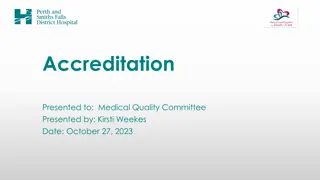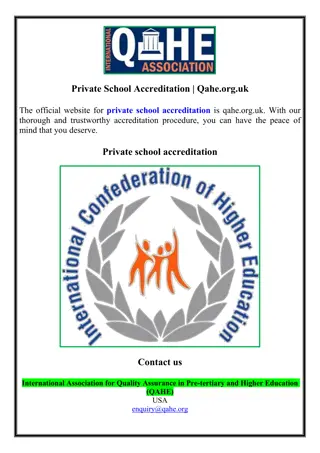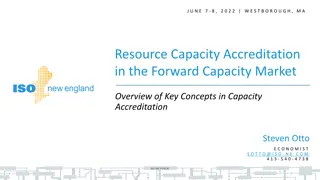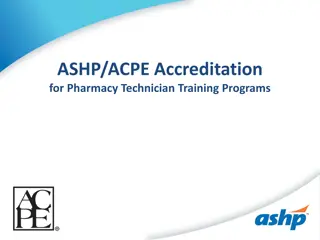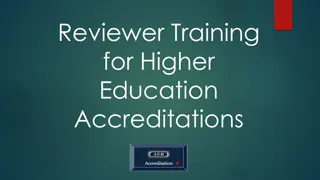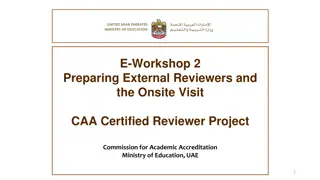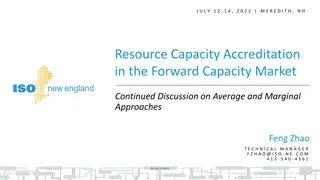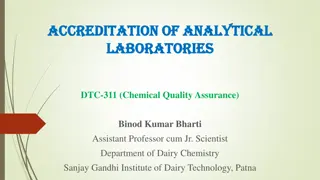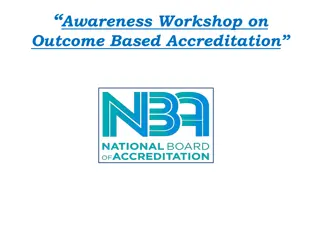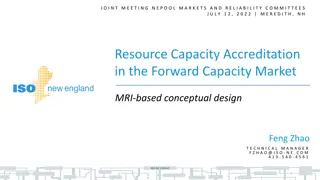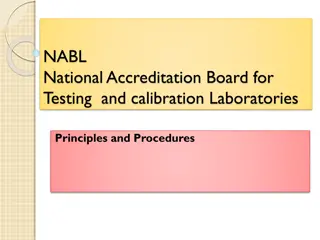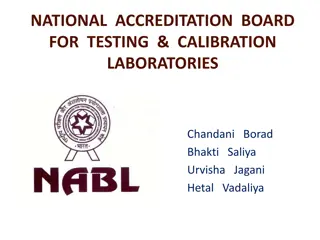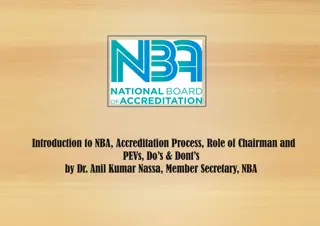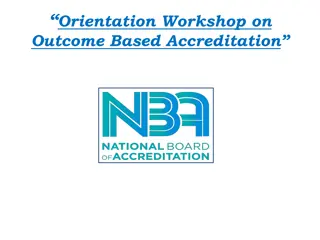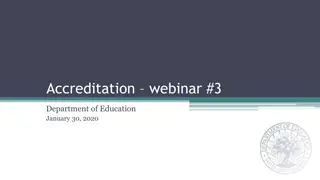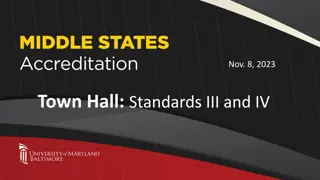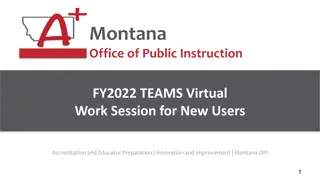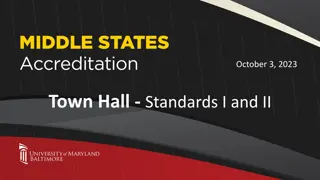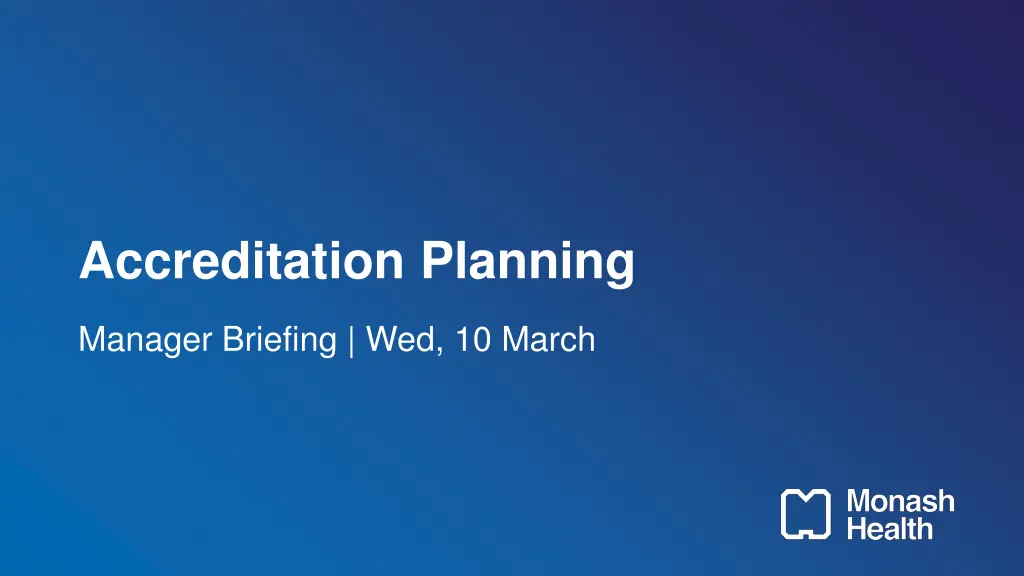
Monash Health Accreditation Planning Manager Briefing
Monash Health will undergo a National Standards accreditation assessment from June 7 to June 11, 2021, focusing on key areas such as patient care, governance, and staff involvement. The process includes consumer engagement, clinical governance, and adherence to National Safety and Quality Health Service Standards. Managers are urged to ensure compliance through performance appraisals, mandatory training, and regular checks on the Accreditation website. Being prepared involves alignment with Monash Health's iCARE values, effective communication, and engagement with improvement projects and frameworks.
Download Presentation

Please find below an Image/Link to download the presentation.
The content on the website is provided AS IS for your information and personal use only. It may not be sold, licensed, or shared on other websites without obtaining consent from the author. If you encounter any issues during the download, it is possible that the publisher has removed the file from their server.
You are allowed to download the files provided on this website for personal or commercial use, subject to the condition that they are used lawfully. All files are the property of their respective owners.
The content on the website is provided AS IS for your information and personal use only. It may not be sold, licensed, or shared on other websites without obtaining consent from the author.
E N D
Presentation Transcript
Accreditation Planning Manager Briefing | Wed, 10 March
National Standards Accreditation Monash Health will undergo a National Standards accreditation assessment from Monday, June 7 to Friday, June 11, 2021 One week, 20 assessors, visits to main hospitals, mental health units and some community sites to assess against the 8 national standards Meeting key stakeholders, talking to staff, reviewing processes and documentation Consumer involvement Observational - lots of looking and checking 28/05/2025 2
National Safety and Quality Health Service (NSQHS) Standards Clinical Governance Partnering with Consumers Preventing and Controlling Healthcare-Associated Infection Medication Safety Comprehensive Care Communicating for Safety Blood Management Recognising and Responding to Acute Deterioration 28/05/2025 3
Key Messages (1/2) Accreditation will observe and focus on the patient's journey: how patients progress through our care and the ways we support them and their input. Accreditation is a positive process it's an opportunity to showcase the work we do, as part of our business as usual approach to safe patient care, high-quality outcomes for patients, families and carers and good governance. Assessors will be watching, showcase: EMR COVID-19 response (all the extraordinary work over the last 12+ months) COVID-19 Vaccination program 28/05/2025 4
Key Messages (2/2) Important to involve the consumer in all you do re: shared decision making Each employee has a part to play in a successful Accreditation result. For Managers: ensure you have completed performance appraisals (this includes documenting in ESS) and the mandatory training required as part of your role, ensure ward and quality boards are up to date download and complete the relevant Accreditation checklist (available via the Accreditation website). Check the Accreditation website regularly Attend Accreditation Planning forums 28/05/2025 5
Being Prepared: Local area preparation Monash health iCARE values Communication across organisation shows governance is working COVID communication shows this HR on-boarding process, immunisation and vaccination program Clinical Governance framework, health literacy framework, PROMPT framework, Consumer engagement framework Credentialing - roles & responsibilities, scope of practice have evidence of staff if relevant Learn about Consumer Advisors role committee members, review patient information, documents, review data this is extremely valued Improvement projects be aware of projects in your area and the organisation showcase EMR, COVID19 work, COVID vaccine program Mandatory and targeted training show data >90%, show PPE training 28/05/2025 6
Being Prepared: Local area preparation Checklists review and tick off with your employees Ensure Welcome to Ward Board, Quality Board, Journey Boards, New Ideas Boards are all current and up-to-date Patient journey demonstrate in EMR, flow from ED/home to discharge, care plans and risk assessments Patient communication boards correct information, updated daily with patient Quality Improvement Plan up to date, write a brag list, advertise your data PROMPT access - procedures and guidelines, staff all have access Ward governance meetings/relevant meeting minutes minutes/agendas available if asked Huddles, MDT meetings assessors will observe, invite them to meeting Performance appraisals up to date Cleaning schedules Linen storage and transporting 28/05/2025 7
Being Prepared: Local area preparation Keep yourselves informed - Aboriginal and Torres Strait Islanders identification, support, services available, RAP Handover for all transfers of care Posters- family escalation of care, complaints, rights & responsibilities brochure Ensure you are familiar with Consumer Advisor and volunteer roles Referral and discharge planning for all patients Goals of care and Alerts documented Maintain a safe environment OVA strategy OH&S inspections up to date, declutter areas Collect relevant evidence for each standard (electronically) Be aware of PICMoRS method Assessors will use this during survey (info available on the Accreditation website) 28/05/2025 8
Being Prepared: Local area preparation Data Riskman Feedback Infection Control Risk Assessment ISR 1 & 2 SCIRTS VHES, MHES, surveys, patient experience team Point of Care Audits, hand hygiene compliance, aseptic technique etc. Complaints followed up Assessors will talk to patients and families Medication errors/falls etc. OHS audits Cleaning schedules and audits 28/05/2025 9
High-risk activities for employees Meal delivery times hand gel on trolleys All transfers of care PSA s transporting patients have checked identification Handovers needs to be consistent across organisation ISBAR framework Assessors will watch several over the week 5 moments hand hygiene audit results need to align with our practice Patient identification prior to medication administration Visits to theatre, CSSD, PACU is an assessors paradise abundance of staff performing various tasks with patient Staff awareness of consumer advisory role at Monash Health Wash hands if walking assessors to various departments 28/05/2025 10
Evidence per Standard Manager Briefing
Clinical Governance Standard Evidence (1/2) Communication distributed to the workforce how is this performed Training - mandatory and targeted training Education and training across the workforce credentialing and scope of practice People and Culture all HR, on-boarding process, performance appraisals, contracts, PD s, orientation manuals etc. Quality Boards, Welcome boards, OHS boards current and present data QIP (actions for audit outliers, improvement activities) Ward/unit meeting minutes and Terms of Reference where quality/risk/audit/feedback/complaints is discussed Risk incident reporting, example of recent investigation & actions/outcomes e.g. SKIRT Consent process Awareness of Clinical Governance framework 28/05/2025 12
Clinical Governance Standard Evidence (2/2) Workplace inspections OHS, safe environment, OVA strategy Patients health record correct documentation, privacy, record available at point of care How to report broken equipment or hazard What to do in EMR downtime Orientation manual process Equipment maintenance schedule Daily checks in EMR documented (o2/suction) Evacuation plans/maps/posters current OHS workplace inspections Declutter old folders, hazards, corridors, equipment 28/05/2025 13
Partnering with Consumer Standard Evidence (1/2) Patient Information How to access, what's available, ensuring patients/carers receive Developing and reviewing, consumer review Rights and Responsibilities available in different languages, visible and accessible in all areas Welcome packs current and relevant Welcome to Ward boards You said, We did Ensure patients have consented and are involved in decisions about their care (Shared Decision Making) Awareness of Health Literacy framework 28/05/2025 14
Partnering with Consumer Standard Evidence (2/2) Consumer engagement framework and consumer participation procedure Consumer representatives on all standards committees and subcommittees Engagement of patient in EMR, being involved in care e.g. goals documented, care plans in place Complaints and compliments responding, service recovery, data Example of improvement activity with consumer involvement Teach back method staff to use and demonstrate, this confirms consumers understanding information Patient experience data e.g. VHES survey, MHES (BI portal), patient questions in point of care audits Interpreter services how to access Understand cultural considerations/how to access aboriginal liaison officer 28/05/2025 15
Preventing and Controlling Healthcare Associated Infections Standard Evidence (1/2) Latest hand hygiene audit results Cleaning schedules (including ice machine) Clean equipment schedule e.g. clinical, EMR devices Infection Control risk assessments (check dates and actions) Staff health flu vaccination rate and immunisation process Infection data reports (if relevant) Isolation protocols and signage 28/05/2025 16
Preventing and Controlling Healthcare Associated Infections Standard Evidence (2/2) Clinical waste correct management Aseptic technique training statistics Aseptic technique and transmission based audit results Invasive device documentation including labelling lines, dates, changing PIVC every 72hrs PPE COVID intranet site Spill kits accessibility, know how and when to use 5 moments - discuss with staff, as assessors will be watching 28/05/2025 17
Medication Safety Standard Evidence (1/2) Be familiar with some of the Medication Safety initiatives and processes implemented across Monash Health: Smart pumps with error reduction software to improve patient safety (for which data libraries are updated regularly) Medication related Procedures, Clinical Guidelines and Medication Profiles available via PROMPT Where to find medicines information (Pharmacist, Medicines information Service, online resources AMH, MIMs online, Australian Injectable Drugs Handbook etc.) Medication Safety training package via LATTE Medication Safety initiatives implemented for management of high risk medicines (PINCH) 28/05/2025 18
Medication Safety Standard Evidence (2/2) Safe storage of medicines in clinical areas (locked medication storage facilities, sealed bags for storage of patients own Schedule 8 and 4D medicines) Provision of a discharge summary and discharge medication list to patients (also communicated to the GP) Labelling of injectable medicines, fluids and lines in accordance with the National Standard Clinical staff obtaining a best possible medication history Clinical staff completing a Medication Management Plan 28/05/2025 19
Medication Safety Standard Ensure Medication related in-services provided Management of look-alike sound-alike medicines (labelling of hydromorphone oral liquid) Medicine related incident reports are available and regularly discussed with clinical staff Temperature monitoring of medication and vaccine refrigerators is up to date and documented on the correct monitoring form Lock codes for medication storage facilities are changed annually (at a minimum) Staff are aware of how to report and document an adverse drug reaction Staff are aware of medicines related quality improvement projects applicable to your area 28/05/2025 20
Comprehensive Care Standard Evidence (1/2) Demonstrate the flow of care in EMR from admission to discharge inclusive of referrals, all disciplines notes (assessors may pick a patient) Targeted training LMS packages e.g. falls, delirium, nutrition, pressure injury Demonstrate completing care plans in EMR Complete risk assessments not just on admission (PI, falls, MUST, 4AT, skin assessments) Show strategies in place appropriate to risk assessment rating Mental state of patient in acute setting referral process Point of care audit results, ward scorecards what have you done with the results EMR reports/dashboards care plan usage and risk assessment completion - show assessors 28/05/2025 21
Comprehensive Care Standard Evidence (2/2) MDT meetings define patient goals End of life care/Advance care planning referral process Equipment registry e.g. falls, pressure injury prevention stock, ordering, maintenance process Pressure injury (hospital acquired) incident report data Falls incident report data Post falls management and expert wound management Nutrition Meal supervision, dietary requirements including cultural, how to access food afterhours FBC documentation in EMR Rounding checks Restraint and seclusion how is this managed, escalated and documented 28/05/2025 22
Communicating for Safety Standard Evidence All patients wearing identification band Staff checking 3 identifiers when required Assessors will observe Communication Board correct template, up to date, involve patient/carer Clinical alerts how identified, what are they (PROMPT Document) Patient discharge information teach-back method used with patients Point of care audit results - identification and handover Observational Handover with EMR assessors will watch, involve patient Clinical Alerts in EMR ensure handed over as critical information ISBAR framework used when handing over care Transporting of patient s, e.g. to x-ray ensure checks occur Theatre Timeout process and audits assessors will observe a timeout in progress Demonstrate multidisciplinary team meetings and huddles invite assessor to meeting 28/05/2025 23
Blood Management Standard Evidence Administration checklist completion in EMR All patients receive information on blood products before transfusion know how to access Blood and blood products training (BloodSafe) completion Transporting of blood PSA s training statistics Blood administration protocols, observations documented and completed Completed consent forms at point of care check SMR for any annual consents Smart pump show assessors blood protocol built into pump for administration, great safety initiative Blood audit results Riskman transfusion incidents examples if relevant Understanding and awareness of the massive transfusion protocol Transfusion Reactions how to manage, escalate, report/document Transfusion Services Intranet page resources for blood management 28/05/2025 24
Recognising and Responding to Clinical Deterioration Standard Evidence (1/2) Vitals completed as per individualised monitoring plan Adult - Adult Clinical Observation & response procedure Paediatric & Neonates Clinical Observations Paediatrics procedure Altered Monitoring of mental state in EMR Conscious state 4AT / CAM-ICU Safety checks completed and documented every shift in EMR Escalation of care process for physiological deterioration Resuscitation trolley checks up to date 28/05/2025 25
Recognising and Responding to Clinical Deterioration Standard Evidence (2/2) BLS/ALS training up to date Evidence of workforce attendance at any acute deterioration management workshops / in-services e.g. S.O.U.P MET call/Code Blue data & clinical incident investigations (delayed METs, equipment issues, communication failures) Goals of care completion in EMR all patients Family escalation of care posters visible (new template) EMR alerts observation charts, clinician review and MET call criteria Point of care results deteriorating patient questions SCIRT serious event example, learnings in place 28/05/2025 26
If there are any issues during survey week Contact Quality for assistance Stay calm and say very little until you understand exactly what is being said Confirm with the lead assessor if they think there is an issue Research the standard action that they are referring to Engage with the Commission if needed Act on the issue and come up with a plan to eliminate it during the assessment develop a plan Manage key stakeholders and manage expectation if it is a serious issue To ensure there are no misunderstandings, all communication will be with the lead assessor. 28/05/2025 27
Resources Accreditation website (accreditation.monashhealth.org) Accreditation webinars Prompt how to access, search function Monash Health Frameworks strategic, quality, procedures, clinical governance, RAP, health literacy, consumer engagement National Standards committees and sub committees Accreditation Checklists Quality Boards, Welcome Boards, New Ideas Boards Quality and Risk Unit, Quality Partners and Managers Power BI, EMR dashboards www.safetyandquality.gov.au factsheets, workbooks www.achs.org.au (The Australian Council on Healthcare standards) 28/05/2025 28


